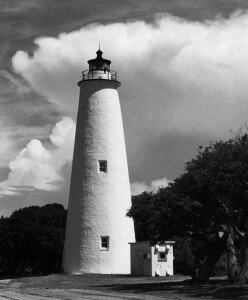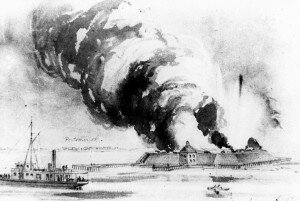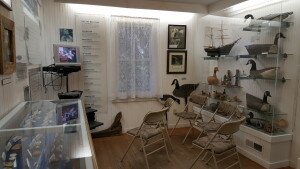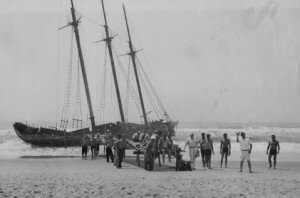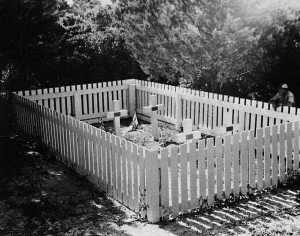One of the best-known old style brick towers is the lighthouse at Ocracoke village on North Carolina’s Outer Banks. Winslow Lewis lost the contract for this 65-footer to Noah Porter, another New Englander. Porter’s work, completed in 1823, has held up well over the years. The photo shows the two most characteristic features of the old style design. The tower is bluntly conical, and the lantern is somewhat off-center because it is positioned over the top of the spiral stairway. The original birdcage lantern is gone, replaced by a mid-nineteenth-century lantern having distinctive trapezoidal windowpanes. The lantern was designed for a fourth order Fresnel lens installed in 1854; this lens was replaced with another fourth order optic in 1895, and that lens remains in use today. The tower’s brickwork was later covered with a stucco-like mortar, painted white. Several other old style brick towers have received similar treatments.
Origin of The Name
(The following history is reprinted with permission from the East Carolina University’s Ocracoke History website)
The exact derivation of the name “Ocracoke” is unknown, though many suggestions have been made. It has been suggested that the name is linked to the Algonquian word “waxihikami” which means enclosed place, fort or stockade. On old maps, the spelling varies from Wokokon, Woccocon, Occacock, Ocacoe, Ocacock, Occacock, Ocreecock and now Ocracoke. A more far-fetched suggestion is that Blackbeard the Pirate, waiting for the fateful dawn of November 22, 1718, prayed in vain “O Crow Cock! O Crow Cock!” in hopes of escaping his pursuers. A good primer on island names can be found at Philip Howard’s Ocracoke Newsletter Website.
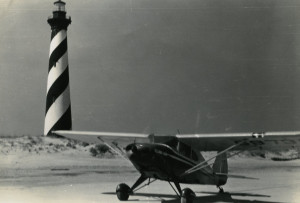 The Outer Banks along the coast of North Carolina is a string of islands defined by inlets connecting the Atlantic Ocean on the east with the sounds which extend in places as much as thirty miles westward toward the mainland. These inlets have shifted over time; some have closed entirely, new ones have opened, some have migrated along the islands and their depth continually changes due to the vagaries of weather and current (Newell 1987:1). The shifting depth and width of these inlets hindered maritime activity. Only a few of the many inlets were deep enough to admit the passage of moderate-sized vessels into the sounds. These inlets included Roanoke, Currituck, Topsail and Ocracoke. Roanoke and Currituck were frequently used during North Carolina’s early history, but became too shallow to admit any but the smallest vessels by the 1730’s. Topsail Inlet had achieved some importance by this time, but poor transportation connections with the interior limited the growth of its commerce. With the exception of the region served by the Cape Fear River, much of the colony’s commerce was channeled through Ocracoke Inlet (Newell 1987:1).
The Outer Banks along the coast of North Carolina is a string of islands defined by inlets connecting the Atlantic Ocean on the east with the sounds which extend in places as much as thirty miles westward toward the mainland. These inlets have shifted over time; some have closed entirely, new ones have opened, some have migrated along the islands and their depth continually changes due to the vagaries of weather and current (Newell 1987:1). The shifting depth and width of these inlets hindered maritime activity. Only a few of the many inlets were deep enough to admit the passage of moderate-sized vessels into the sounds. These inlets included Roanoke, Currituck, Topsail and Ocracoke. Roanoke and Currituck were frequently used during North Carolina’s early history, but became too shallow to admit any but the smallest vessels by the 1730’s. Topsail Inlet had achieved some importance by this time, but poor transportation connections with the interior limited the growth of its commerce. With the exception of the region served by the Cape Fear River, much of the colony’s commerce was channeled through Ocracoke Inlet (Newell 1987:1).
Revolutionary Period
Throughout the American Revolution, British vessels and privateers made numerous raids at Ocracoke Inlet, with several attempts to blockade the inlet against all vessels sustaining the Patriot cause. These activities led to the establishment of American land and naval forces at the inlet, which continued to serve as a crucial artery of supplies until the struggle for independence was won.
War of 1812
Throughout the War of 1812, Ocracoke Inlet served as a base of operations for privateers and as an important avenue for supplies bound for southeastern Virginia through the “back door.” An enemy attack on the area had been feared since the beginning of hostilities, and in the summer of 1813 the British made their appearance in considerable force: At daybreak, July 12, the residents of Portsmouth, Ocracoke and Shell Castle awoke to find a formidable British fleet anchored just off the Bar, including nine large war vessels. Barges soon put off from the ship – one observer counted nineteen barges, each carrying forty men – and when they entered the inlet they attacked two American privateers, the Anaconda and the Atlas, and a revenue cutter, capturing the privateers and forcing the cutter to retreat up the sounds. Then the British troops landed at Portsmouth and Ocracoke, collected hundreds of cattle and sheep, and after five days on the Banks weighed anchor and sailed away, announcing before their departure that the entire coast of North Carolina was under blockade (Dunbar 1958:39,150). Admiral Cockburn, commander of the British naval force, had initially planned to proceed up the Neuse River and capture New Bern. The escape of the revenue cutter to New Bern, however, removed the necessary element of surprise, and the proposed attack was abandoned. This was to be the only British incursion into the area of Ocracoke Inlet. When hostilities ceased, attention was directed toward methods of improving the inlet as an artery of commerce (Dunbar 1958:39).
Soon after the outbreak of the Civil War, Confederate forces seized the existing forts along the coast of North Carolina and began construction of additional fortifications on Roanoke Island and at Hatteras, Oregon and Ocracoke Inlets. The Ocracoke facility was situated on Beacon Island, where an earlier fortification had existed during the War of 1812. Of octagonal shape, the Civil War installation was known alternatively as Fort Ocracoke or Fort Morgan. In addition to a garrison there, it was reported that several hundred troops were stationed at Portsmouth and on the beach below Ocracoke Inlet. All told, there were about 500 Confederate troops in the area (Rush 1914:80). For more information on Fort Ocracoke and during the Civil War, please check out the SIDCO site
Ocracoke Brogue
Because of its isolation, Ocracoke speech patterns have taken on a unique dialect, or “brogue“, and expressions over the past 250 years. Ocracoke brogue is the famous local dialect. To some of the native islanders, there are only two kinds of people in the world: O’Cockers and dingbatters (natives and non-natives, respectively). For more information, click on the link above which will take you to the Ocracoke Linguistics site of the North Carolina Language and Life Project at the North Carolina State University.
Brogue Room
The permanent exhibit in the OPS Museum, complete with continuous play video, reflects the on-going research of Walt Wolfram, a North Carolina State University linguist and self-described “wampus cat” (that’s O’Cocker for someone abnormal!).
The existence of the Navy and Coast Guard installations on Ocracoke during World War II brought numerous servicemen from outside the area and had an invigorating effect on the local economy. Ocracoke prior to the war was seeing approximately 3,000 visitors each summer to fish and swim, while another 500 visitors flocked to the island each fall and winter for duck hunting (United States Congress No.325:6). The establishment of Cape Hatteras National Seashore in 1953 brought a steady flux of outsiders. Restricting the flow of tourists were the difficulties in reaching the island and the lack of roads on the island itself. These impediments were eliminated in 1957 with the creation of the state’s establishment of year-round, toll-free ferry service across Hatteras Inlet, and the completion of a paved road between Ocracoke Village and the ferry terminal.
Since 1953 all of Ocracoke Island, with the exception of Ocracoke Village, has been under federal ownership as a part of the Cape Hatteras National Seashore, administered by the National Park Service. The island remains unspoiled and in its natural state, the only improvements being the state road and about ten miles of sand-fence barrier.
The tiny British graveyard on Ocracoke Island contains four graves, two of which are marked “Unknown.” A third bears the name of Lt. Thomas Cunningham, and the fourth that of Stanley R. Craig, A.B. The words “Royal Navy” and “Body found May 14, 1942” are inscribed on all four of the bronze plaques on concrete crosses erected at the time of burial. All bodies are identified as members of the crew of HMS Bedfordshire which disappeared with all aboard en route from Norfolk to Morehead City, its temporary “home” port. Rites at Ocracoke were held by the late Amasa Fulcher, prominent layman of the local Methodist Church. A year later, at Mrs. Cunningham’s request, a Catholic service was held by the Navy chaplain, then stationed at Ocracoke. Land for the British burials was given by Mrs. Alice Wahab Williams near the Williams family graveyard. Markers were made by the T.A. Loving Construction Co., then building the Navy base nearby. A commemorative service is held each year in May.
If you would like more information on Ocracoke please see Ocracoke Village Site and Ocracoke Navigator
